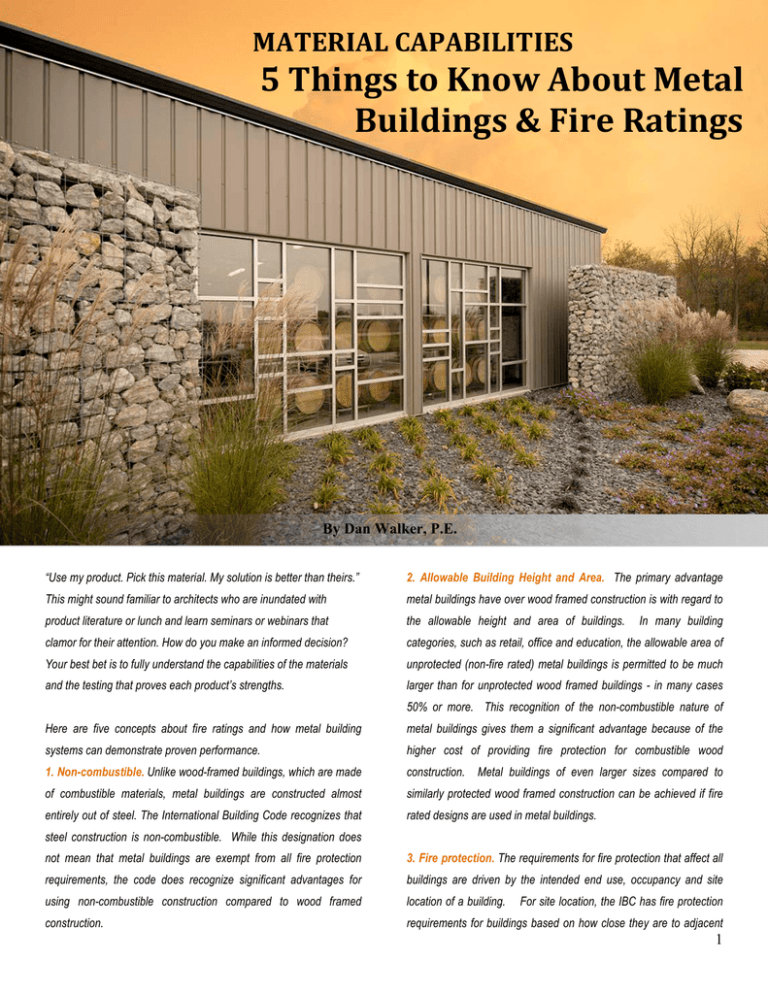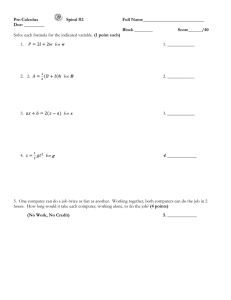
MATERIAL CAPABILITIES
5 Things to Know About Metal
Buildings & Fire Ratings
By Dan Walker, P.E.
“Use my product. Pick this material. My solution is better than theirs.”
2. Allowable Building Height and Area. The primary advantage
This might sound familiar to architects who are inundated with
metal buildings have over wood framed construction is with regard to
product literature or lunch and learn seminars or webinars that
the allowable height and area of buildings.
clamor for their attention. How do you make an informed decision?
categories, such as retail, office and education, the allowable area of
Your best bet is to fully understand the capabilities of the materials
unprotected (non-fire rated) metal buildings is permitted to be much
and the testing that proves each product’s strengths.
larger than for unprotected wood framed buildings - in many cases
In many building
50% or more. This recognition of the non-combustible nature of
Here are five concepts about fire ratings and how metal building
metal buildings gives them a significant advantage because of the
systems can demonstrate proven performance.
higher cost of providing fire protection for combustible wood
1. Non-combustible. Unlike wood-framed buildings, which are made
construction.
of combustible materials, metal buildings are constructed almost
similarly protected wood framed construction can be achieved if fire
entirely out of steel. The International Building Code recognizes that
rated designs are used in metal buildings.
Metal buildings of even larger sizes compared to
steel construction is non-combustible. While this designation does
not mean that metal buildings are exempt from all fire protection
3. Fire protection. The requirements for fire protection that affect all
requirements, the code does recognize significant advantages for
buildings are driven by the intended end use, occupancy and site
using non-combustible construction compared to wood framed
location of a building.
construction.
requirements for buildings based on how close they are to adjacent
For site location, the IBC has fire protection
1
buildings or property lines. The risk of fire spreading from building to
assemblies passed the tests and are now known as UL Design Nos.
building decreases as the distance between buildings increases.
W404 (1-hour rated fire wall) and W413 (2-hour rated fire wall). Both
Likewise, the fire-resistance rating requirements go down with this
designs allow for new and retrofit metal building use and provide the
lower risk, with the strictest requirements applying to combustible
flexibility to meet future energy code requirements for higher
construction such as wood. Additional stipulations are set for fire
insulation levels.
ratings based on the intended use of the building, or occupancy type,
5. Fire rating materials. The most common fire rating material used
and the construction type, such as wood, steel, or concrete.
in metal buildings is gypsum wallboard. Other materials can be used,
including concrete masonry for walls, and spray-applied fire resistive
4. UL ratings = proven performance.
The Metal Building
materials. All the MBMA fire-rated designs utilize the generic 5/8-
Manufacturers Association designed and tested myriad fire rated
inch "Type X" gypsum wallboard as a minimum, so any gypsum
assemblies for roofs, walls, columns, and joints at Underwriter's
supplier's Type X board will comply. Each design is specific and will
Laboratory. The newest of these listings are UL Design Nos. W404
detail the thickness and number of required gypsum layers, supports,
and W413, which are 1- and 2-hour exterior wall fire ratings,
screw spacing and any other details necessary to achieve the rating.
respectively.
The new exterior wall assemblies consist of non-
combustible metal building wall framing, steel furring, gypsum board,
For joints and penetrations, there are other UL ratings that call for
and exterior metal wall panels as well as several insulation options.
special details that can involve items like intumescent fire caulks that
The assemblies were arranged to maximize the span of the girts
can expand in a fire to help seal any gaps or cracks that occur,
(horizontal metal wall framing) that can be spaced as far apart as 90
preventing the passage of smoke and flames. For instance, MBMA
inches on center (vertical spacing). This is important because most
developed UL Design Nos. CJ-D-0005, CJ-D-0006 and CJ-D-0007
metal building projects incorporate the larger girt spacing for the first
that are wall continuity joint systems that maintain the joint between a
wall girt up from grade level to accommodate door framing.
fire-rated interior partition wall and a non-rated metal roof. Other
details exist for rated interior walls that terminate against fire-rated
Another important reason for these tests was to ensure metal
metal building roofs. They are HW-D-0488, HW-D-0489 and HW-D-
buildings could continue to meet ever-changing energy code
0490.
requirements. The codes have become more stringent by requiring
thicker insulation for roofs and walls, sometimes requiring the
The Fire Resistance Design Guide for Metal Building Systems,
specification of exterior rigid board insulation. The code changes
published by MBMA, is the complete source for fire protection
were made to reduce thermal transfers between the controlled
information.
temperatures of a building interior and the ambient outside
environment, thus saving energy. However, fire resistance ratings
Metal building construction makes up at least 40 percent of non-
are impacted by the types of insulation used. In addition, using foam
residential, 1- and 2-story building construction in the United States.
plastic insulation can bring additional concerns about fire
Chances are you have worked with a metal building in the past, but if
performance and safety, including a potential extra fuel source and
not, consider the strength and flexibility of a metal building system to
smoke and fire propagation potential. The new MBMA/UL W404 and
meet your clients’ needs.
W413 assemblies address these issues, allowing for energy code
compliance using both fiberglass and rigid board insulation while
_________
maintaining the achieved fire resistive wall assembly ratings.
Dan Walker, P.E. is the Assistant General Manager for the Metal
Building Manufacturers Association, Cleveland, Ohio. To learn more,
Underwriter's Laboratory conducted full-scale fire endurance tests
that adhered to the requirements of ASTM E119, "Standard Test
Methods for Fire Tests of Building Construction and Materials". Both
2
© 2015 Metal Building Manufacturers Association. All Rights Reserved.
visit www.mbma.com




